CADILLAC DEVILLE 1993 7.G Owners Manual
Manufacturer: CADILLAC, Model Year: 1993, Model line: DEVILLE, Model: CADILLAC DEVILLE 1993 7.GPages: 406, PDF Size: 20.78 MB
Page 181 of 406
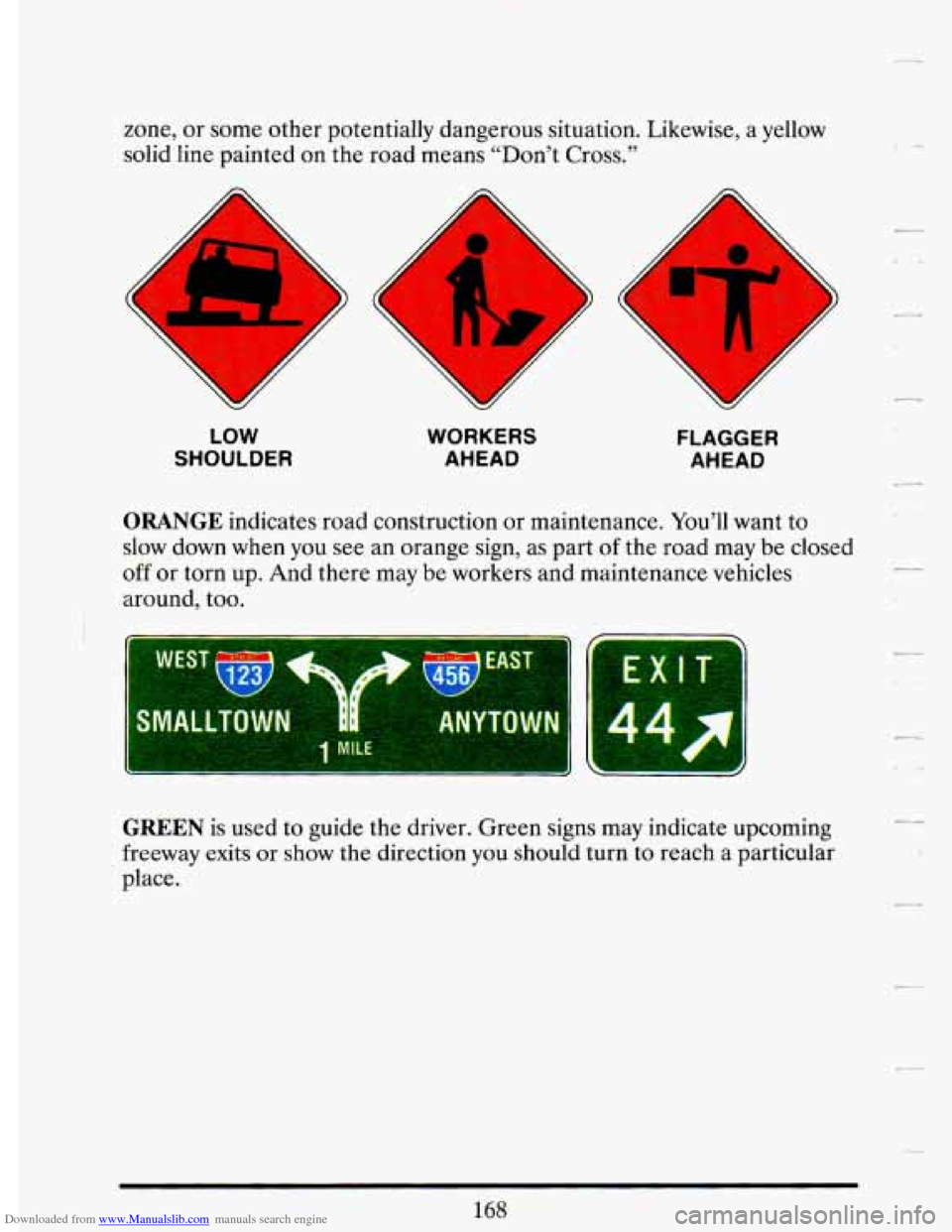
Downloaded from www.Manualslib.com manuals search engine zone, or some other potentially dangerous situation. Likewise, a yellow
solid line painted on the road means “Don’t Cross.”
A
LOW
SHOULDER WORKERS
AHEAD FLAGGER AHEAD
ORANGE indicates
road construction or maintenance. You’ll want to
slow down when you see an orange sign, as part
of the road may be closed
off or torn up. And there may be workers and maintenance vehicles
around, too.
I-
Lr
GREEN is used to guide the driver. Green signs may indicate upcoming
freeway exits
or show the direction you should turn to reach a particular
place.
.-
L.
c-
Page 182 of 406
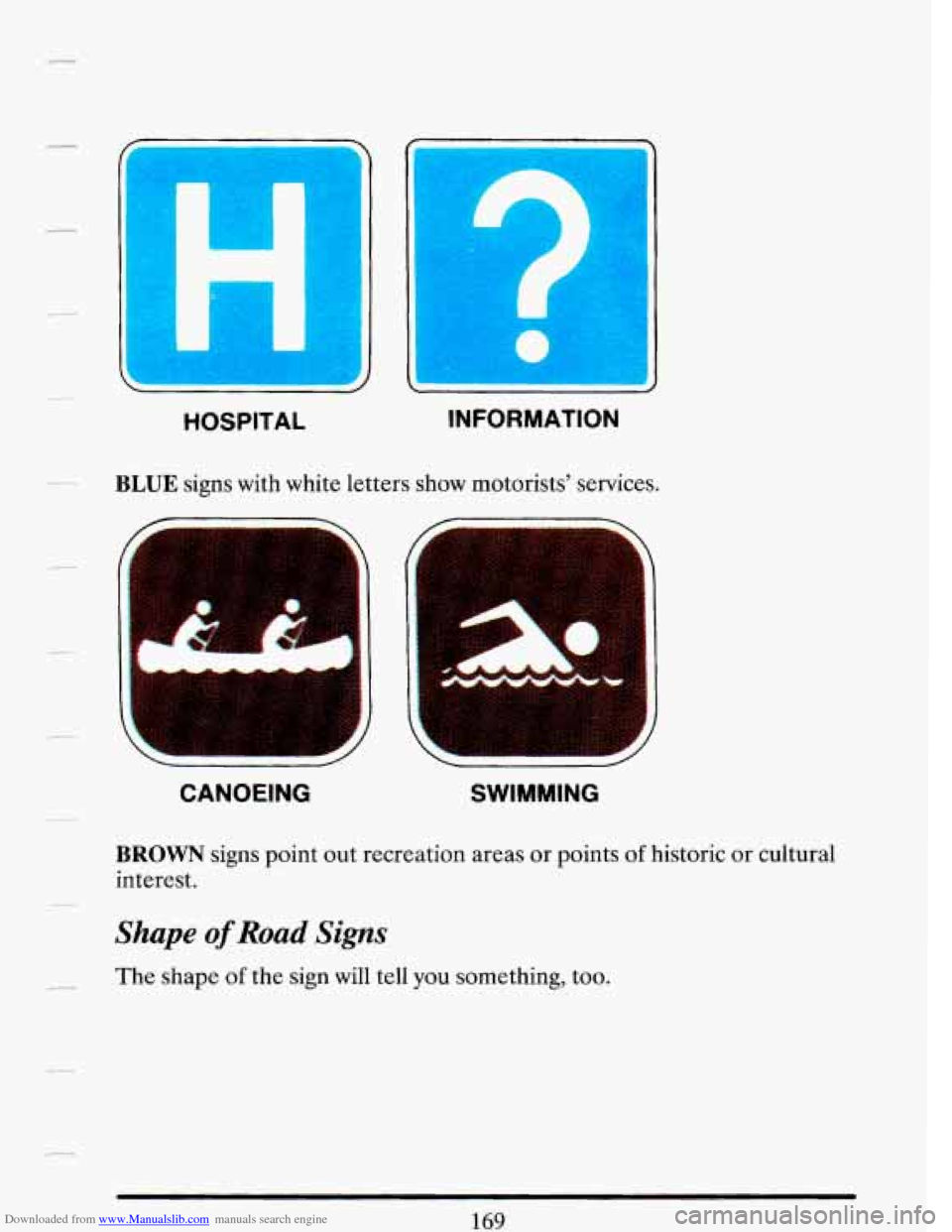
Downloaded from www.Manualslib.com manuals search engine H
I ?
c-
INFORMATION
HOSPITAL
BLUE signs with white letters show motorists’ services.
CANOEING SWIMMING
BROWN signs point out recreation areas or points of historic or cultural
interest.
Shape of Road Signs
The shape of the sign will tell you something, too.
169
Page 183 of 406

Downloaded from www.Manualslib.com manuals search engine /
An OCTAGONAL (eight-sided) sign means STOP. It is always red with
white letters.
A DIAMOND-shaped sign is a warning of something ahead - for
example,
a curve, steep hill, soft shoulder, or a narrow bridge.
A TRIANGLE, pointed downward, indicates YIELD. It assigns the
right-of-way to traffic
on certain approaches to an intersection.
Page 184 of 406
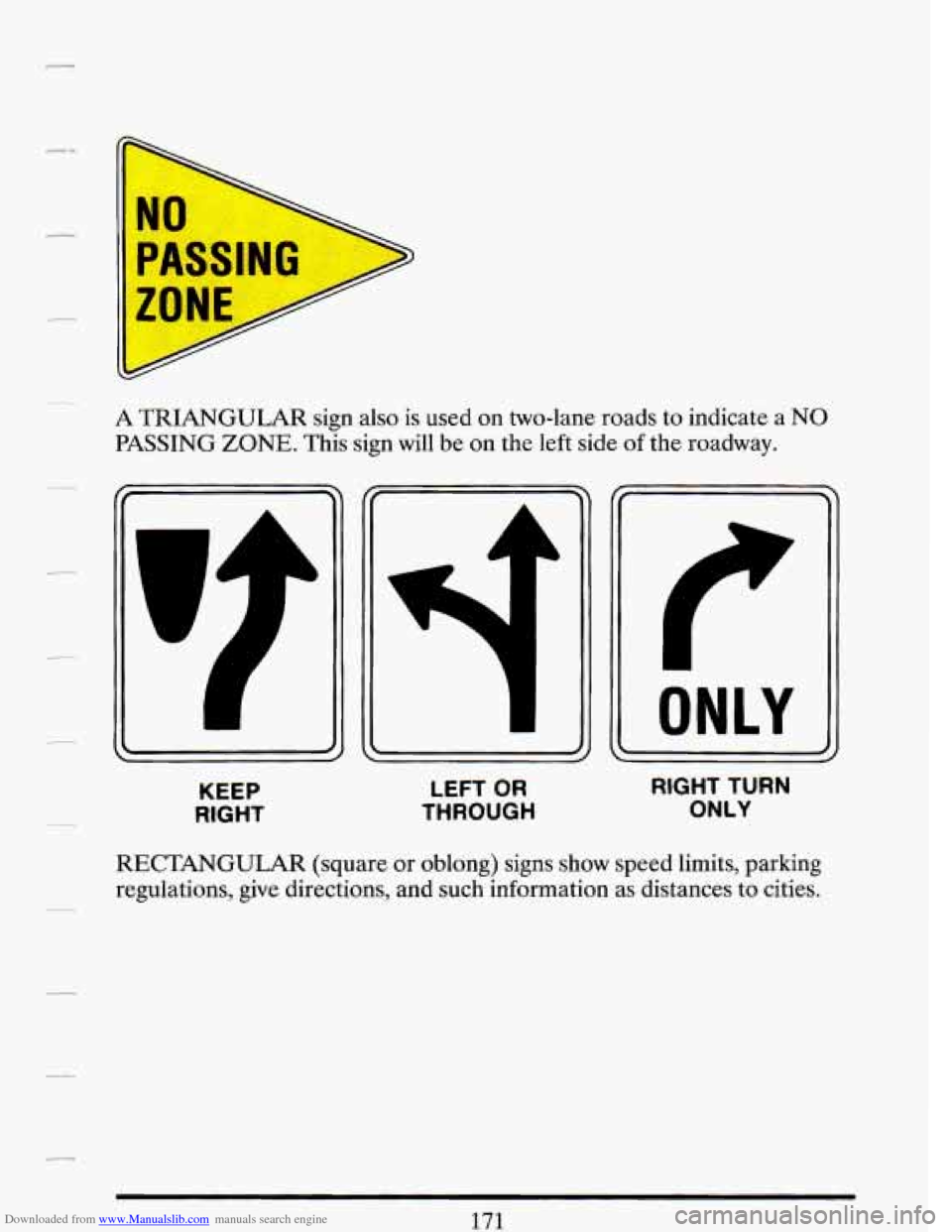
Downloaded from www.Manualslib.com manuals search engine A TRIANGULAR sign also is used on two-lane roads to indicate a NO
PASSING ZONE. This sign will be on the left side of the roadway.
KEEP
RIGHT
LEFT OR RIGHT TURN
THROUGH ONLY
RECTANGULAR (square or oblong) signs show speed limits, parking
regulations, give directions,
and such information as distances to cities.
Page 185 of 406
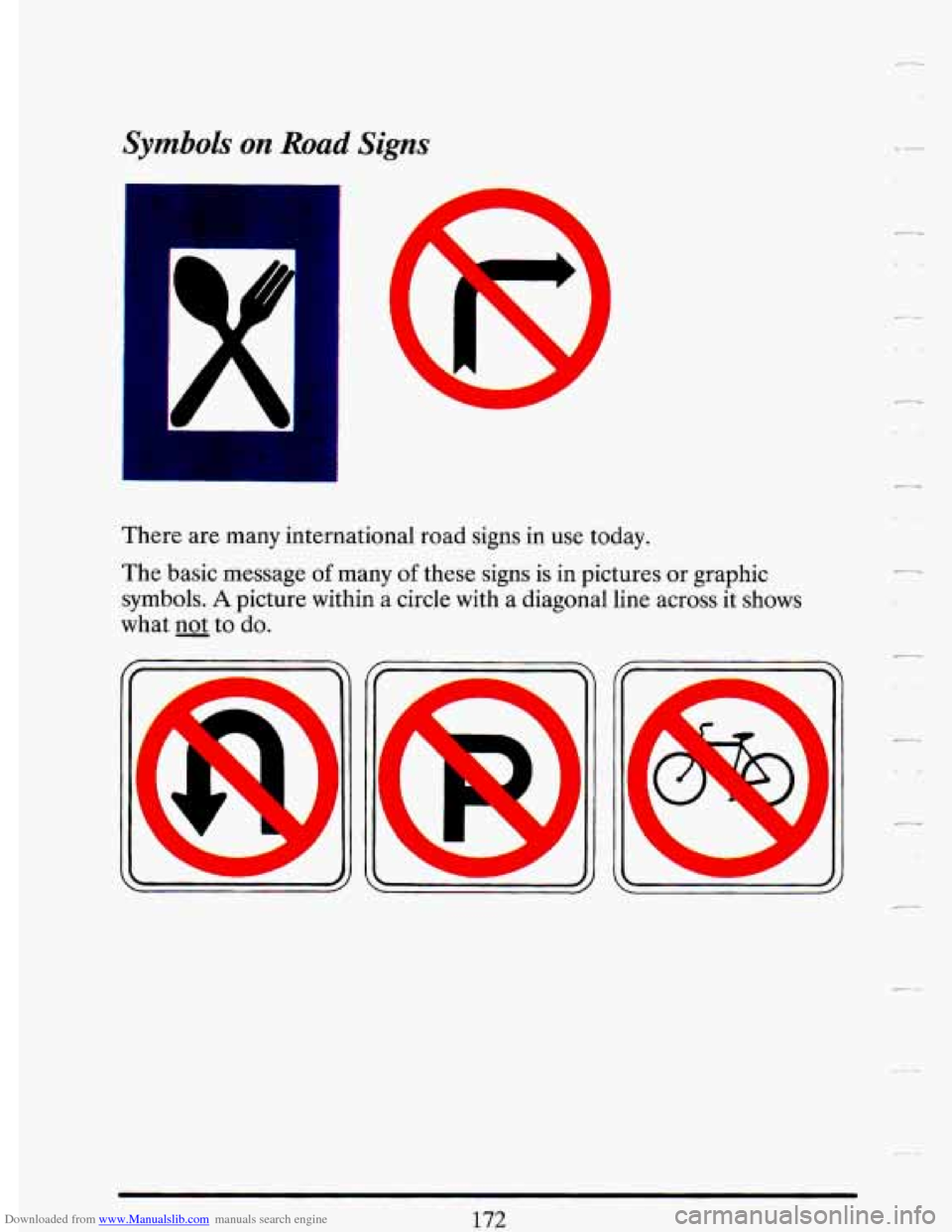
Downloaded from www.Manualslib.com manuals search engine Symbols on Road Signs
t
There are many international road signs in use today.
The basic message
of many of these signs is in pictures or graphic
symbols.
A picture within a circle with a diagonal line across it shows
what
not to do.
I'
t-
i.
Page 186 of 406
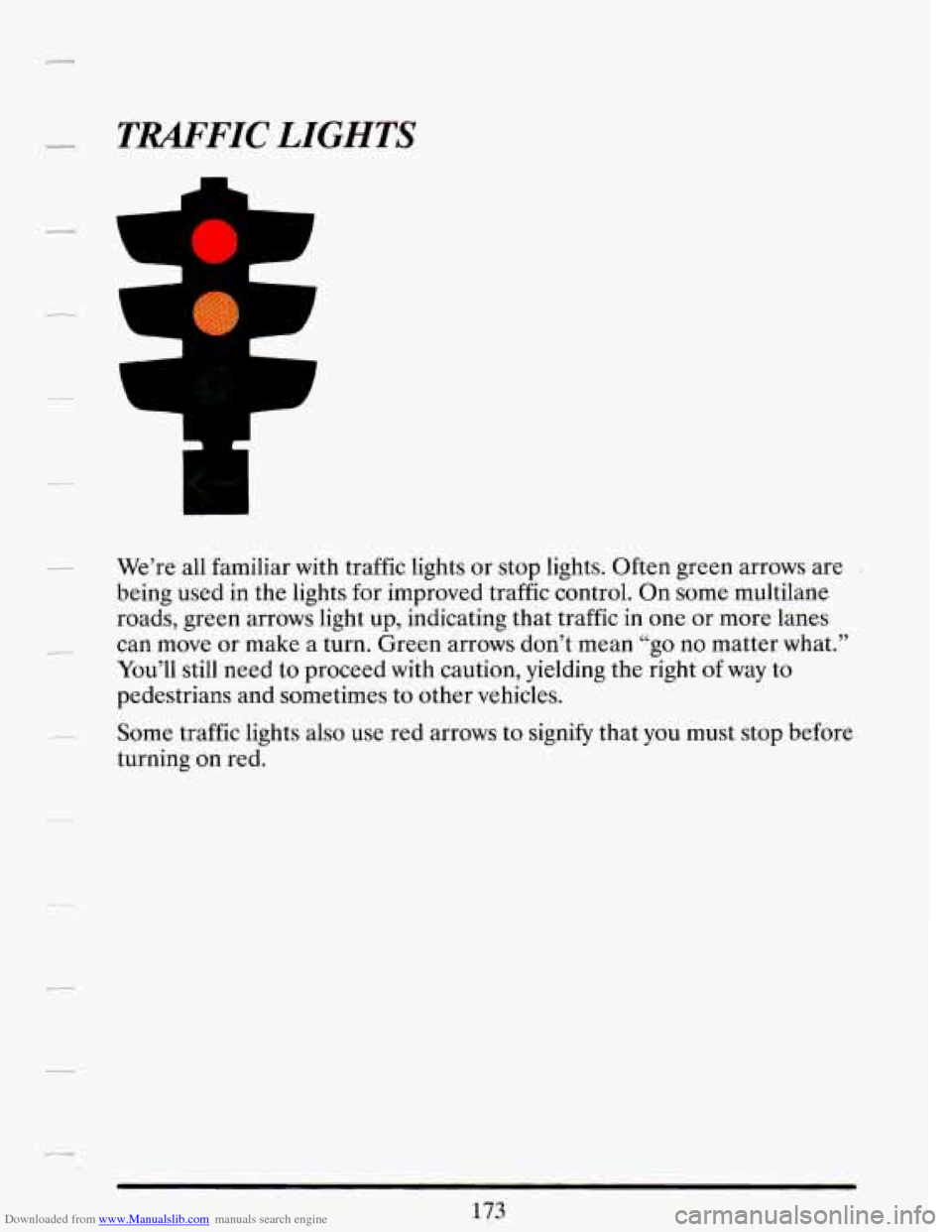
Downloaded from www.Manualslib.com manuals search engine TRAFFIC LIGHTS
m
-1
We’re all familiar with traffic lights or stop lights. Often green arrows are -
being used in the lights for improved traffic control. On some multilane
roads, green arrows light up, indicating that traffic in one or more lanes
can move or make
a turn. Green arrows don’t mean “go no matter what.’’
You’ll still need to proceed with caution, yielding the right
of way to
pedestrians and sometimes to other vehicles.
Some traffic lights also use red arrows to
signify that you must stop before
turning
on red.
Page 187 of 406
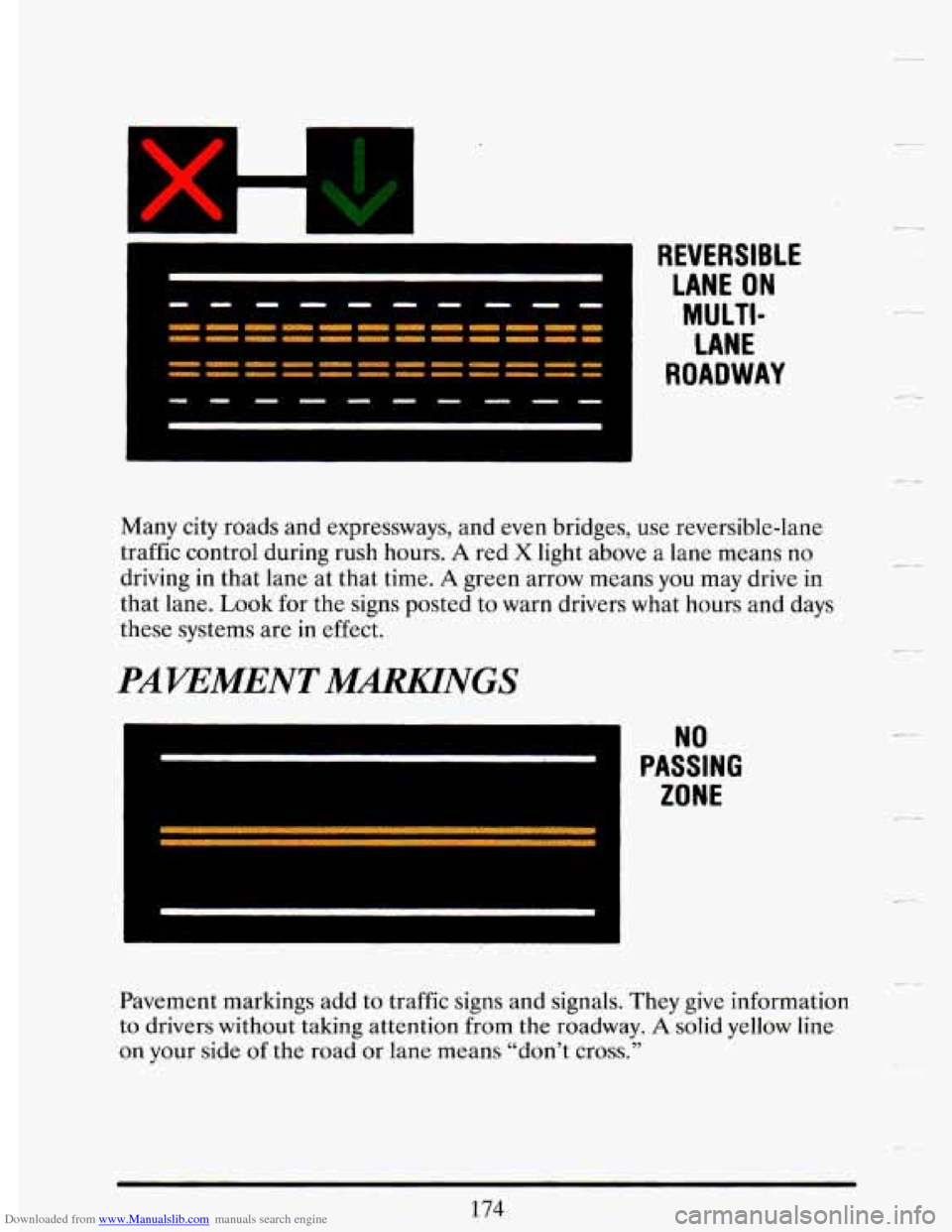
Downloaded from www.Manualslib.com manuals search engine L
- -- VERSIBLE
LANE ON
MU LTI-
LANE
ROADWAY
Many city roads and expressways, and even bridges, use reversible-lane
traffic control during rush hours.
A red X light above a lane means no
driving in that lane at that time.
A green arrow means you may drive in
that lane.
Look for the signs posted to warn drivers what hours and days
these systems are
in effect.
PAVEMENT MWNGS
Pavement markings add to traffic signs and signals. They give information
to drivers without taking attention from the roadway.
A solid yellow line
on your side of the road
or lane means “don’t cross.”
Page 188 of 406
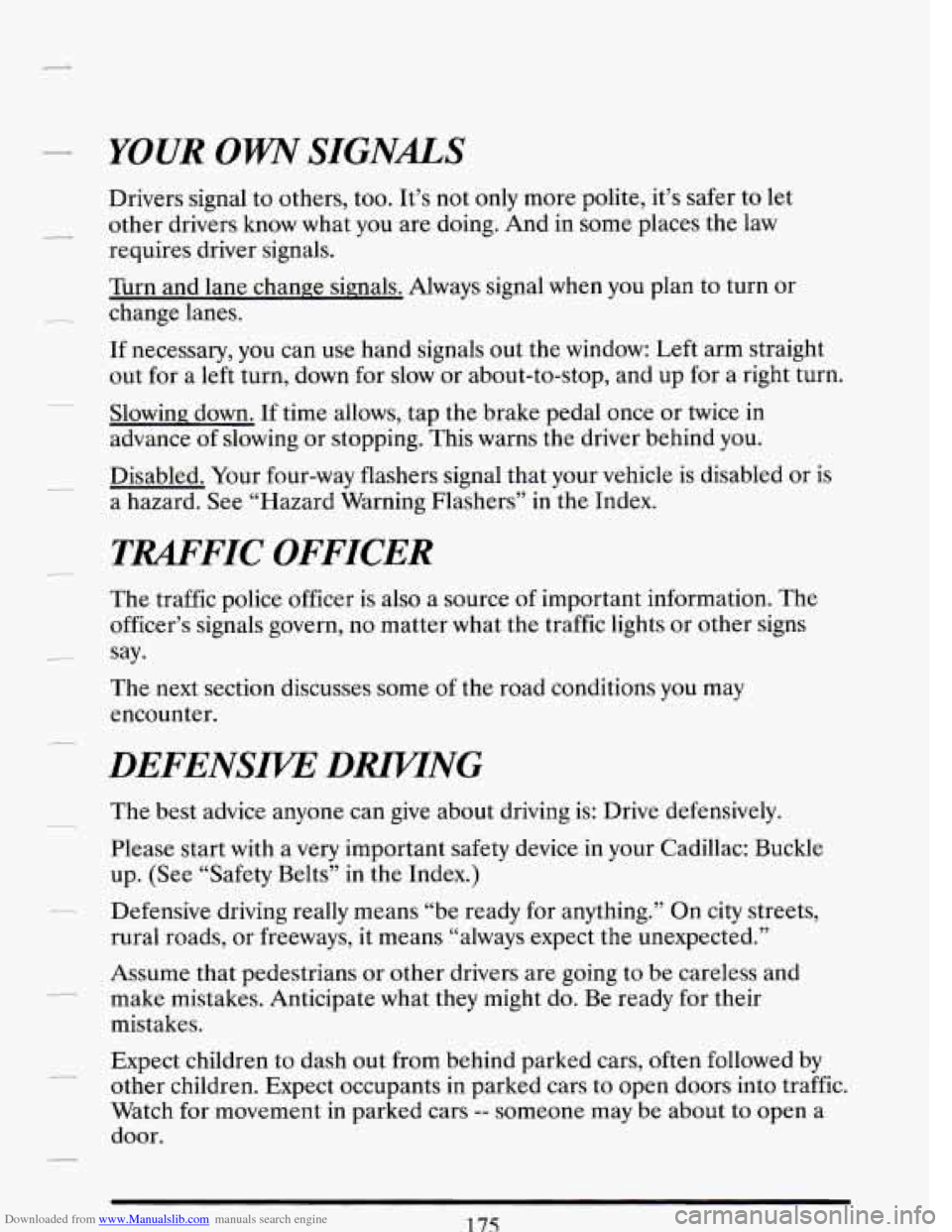
Downloaded from www.Manualslib.com manuals search engine - YOUR OWN SIGNALS
Drivers signal to others, too. It’s not only more polite, it’s safer to let
requires driver signals.
- other drivers know what you are doing. And in some places the law
Turn and lane change signals. Always signal when you plan to turn or
change lanes.
If necessary, you can use hand signals out the window: Left arm straight
out
for a left turn, down for slow or about-to-stop, and up for a right turn.
Slowing down. If time allows, tap the brake pedal once or twice
in
advance of slowing or stopping. This warns the driver behind you.
Disabled. Your four-way flashers signal that your vehicle
is disabled or is
a hazard. See “Hazard Warning Flashers” in the Index.
- TRAFFIC OFFICER
The traffic police officer is also a source of important information. The
officer’s signals govern, no matter what the traffic lights or other signs
say.
The next section discusses some of the road conditions you may
encounter.
DEFENSIKE DmNG
The best advice anyone can give about driving is: Drive defensively.
Please start with a very important safety device in your Cadillac: Buckle
up. (See “Safety Belts” in the Index.)
Defensive driving really means “be ready for anything.”
On city streets,
rural roads, or freeways, it means “always expect the unexpected.”
Assume that pedestrians or other drivers are going to be careless and
make mistakes. Anticipate what they might do. Be ready for their
mistakes.
Expect children to dash out from behind parked cars, often followed
by
other children. Expect occupants in parked cars to open doors into traffic.
Watch for movement in parked cars
-- someone may be about to open a
door.
175
~ -.
Page 189 of 406
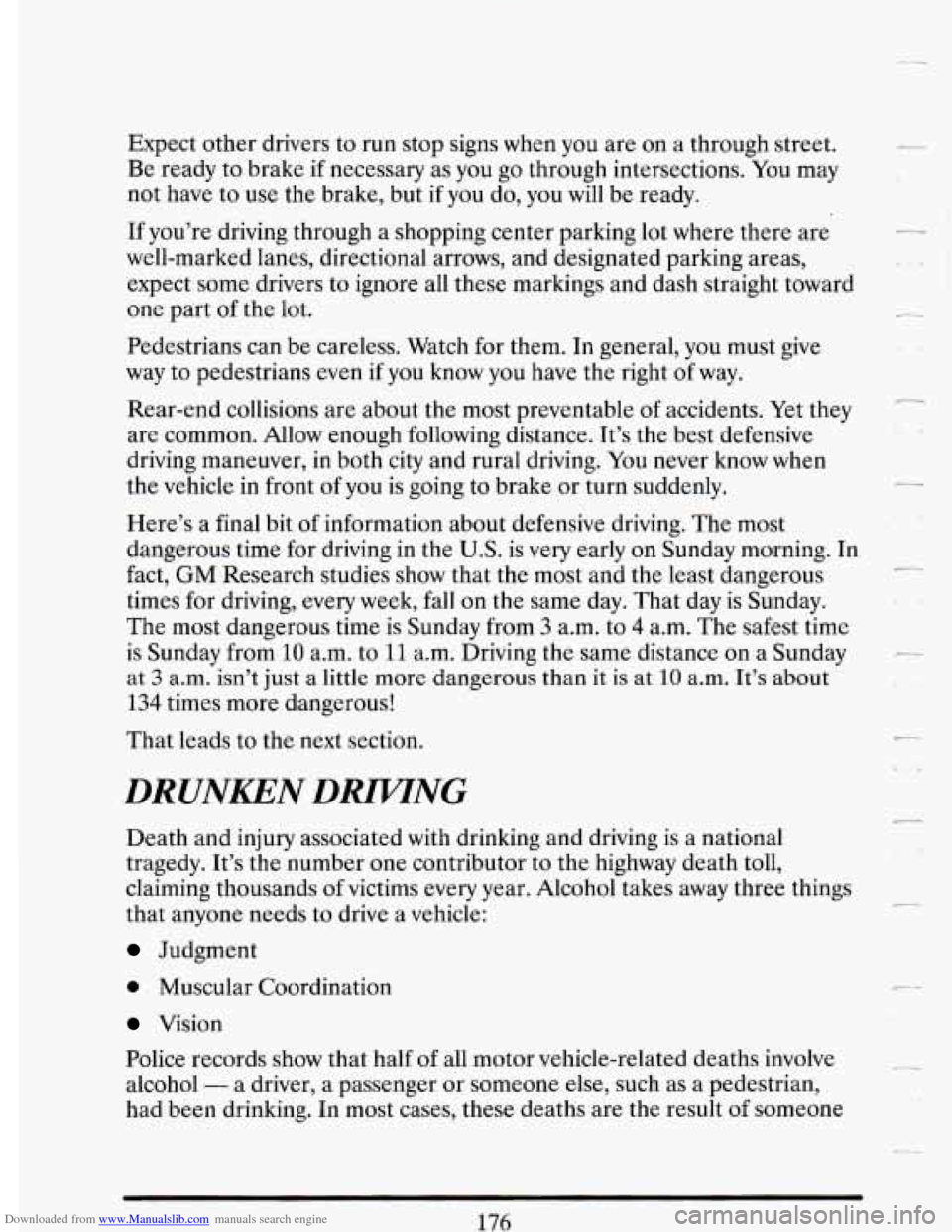
Downloaded from www.Manualslib.com manuals search engine Expect other drivers to run stop signs when you are on a through street.
Be ready to brake if necessary as you go through intersections.
You may
not have to use the brake, but
if you do, you will be ready.
If you’re driving through a shopping center parking lot where there are
well-marked lanes, directional arrows, and designated parking areas,
expect some drivers to ignore all these markings and dash straight toward
one part
of the lot.
Pedestrians can be careless. Watch
for them. In general, you must give
way to pedestrians even if you know you have the right of way.
Rear-end collisions are about the most preventable
of accidents. Yet they
are common. Allow enough following distance. It’s the best defensive
driving maneuver,
in both city and rural driving. You never know when
the vehicle in front
of you is going to brake or turn suddenly.
Here’s
a final bit of information about defensive driving. The most
dangerous time for driving in the
U.S. is very early on Sunday morning. In
fact, GM Research studies show that the most and the least dangerous
times for driving, every week, fall on the same day. That day is Sunday.
The most dangerous time is Sunday from
3 a.m. to 4 a.m. The safest time
is Sunday from
10 a.m. to 11 a.m. Driving the same distance on a Sunday
at
3 a.m. isn’t just a little more dangerous than it is at 10 a.m. It’s about
134 times more dangerous!
That leads to the next section.
-i
r
L.4
DRUNKEN DRMNG
Death and injury associated with drinking and driving is a national
tragedy. It’s the number one contributor to the highway death toll,
claiming thousands
of victims every year. Alcohol takes away three things
that anyone needs to drive a vehicle:
Judgment
0 Muscular Coordination
Vision
Police records show that half
of all motor vehicle-related deaths involve
alcohol
- a driver, a passenger or someone else, such as a pedestrian,
had been drinking. In most cases, these deaths are the result
of someone
176
Page 190 of 406
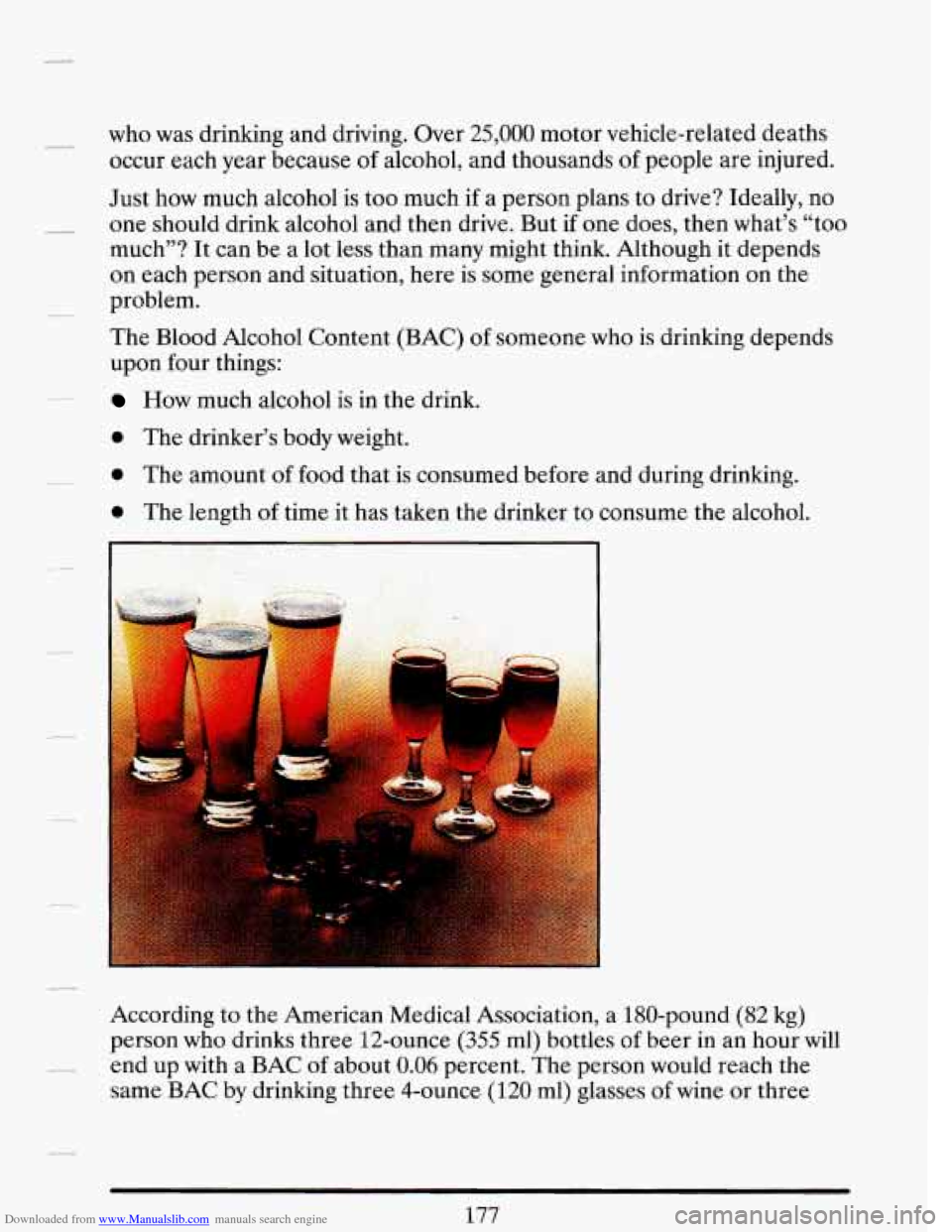
Downloaded from www.Manualslib.com manuals search engine who was drinking and driving. Over 25,000 motor vehicle-related deaths
occur each year because
of alcohol, and thousands of people are injured.
Just how much alcohol is too much if a person plans to drive? Ideally, no
one should drink alcohol and then drive. But
if one does, then what’s “too
much”? It can be a lot less than many might think. Although it depends
on each person and situation, here is some general information on
the
problem.
The Blood Alcohol Content
(BAC) of someone who is drinking depends
upon four things:
How much alcohol is in the drink.
0 The drinker’s body weight.
a The amount of food that is consumed before and during drinking.
0 The length of time it has taken the drinker to consume the alcohol.
I
According to the American Medical Association, a 180-pound (82 kg)
person who drinks three 12-ounce (355 ml) bottles of beer in an hour will
end up with a
BAC of about 0.06 percent. The person would reach the
same BAC by drinking three 4-ounce (120 ml) glasses of wine or three
177